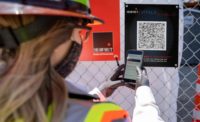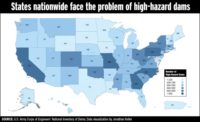
The small headline of the Engineering News article shown here belies the gravity of the disaster: the deadliest dam failure in U.S. history. The South Fork Dam in Pennsylvania was a 72-ft-tall, 931-ft long earth and rockfill structure. After a stop-and-start construction process over a dozen years, it was completed in 1853. The dam went through several changes of ownership and was repaired inadequately. Fish screens were installed that obstructed the spillway and caused water to overtop and erode the structure. This mass of water uprooted trees, rocks, houses, rail cars and animals as it thundered down the valley before smashing into a stone railway embankment. Fires ignited by wrecked locomotives burned for three days. The death toll was 2,208.
Reporters in that era worked under different conditions. The first weekly issue of Engineering News to carry news of the catastrophe was likely printed only three or four days afterward. Information arrived by telegraph, with telephones not yet in wide use and no phone number mentioned on the journal’s masthead. It had an article describing the dam’s structure and two previous nonfatal failures in 1847 and 1862. There also was an editorial that cast blame on the public for not having an official state government engineer overseeing dam safety.
The following week’s issue contained firsthand reporting. The flood damaged rail lines in the Johnstown region, but once rail service resumed four days later, “Two [unnamed] members of the editorial staff of this journal, provided with compass, hand-level, tape-line and camera, left New York.” The ENR staffers traveled by train as far as Rockwood, Pa., and “slept on the clean hay of a dirty barn.” After reaching Johnstown the next day they proceeded to walk 14 miles “up the desolated valley” to the broken dam.
“What they saw en route, and the general state of the valley, we cannot attempt to describe and illustrate in this issue,” the publication continued. “The greatest point of interest to engineers about the disaster is the dam that caused it, and space and time are sufficiently taxed to present the facts in regard to that structure as completely as we do in this issue.” There is a plan and elevation of the ruined dam drawn from surveys made by the reporters, as well as half a dozen engravings of the remnants of the dam and the obstructed spillway. The engravings were made from photographs the reporters took. At that time, printing technology, the halftone process, was not advanced far enough to reliably print photos.
Their article pointed out that one significant factor in the dam failure was sag in its crest, due to predicted settlement over time, which had not been corrected. That rendered the spillway less effective. If there had been no sag in the crest, “the dam would have had an excellent ‘fighting chance’ of surviving intact, since it would have given 1.5 to 2.5 ft more water in the spillway, despite the obstructions…”
In discussing repairs made to the dam in 1879, the journal stated, “As a matter of fact, the rebuilders, who were aided by no engineering advice or supervision whatever ... were greatly less cautious about the spillway area instead of more so,” (emphasis in original text).
One editorial warned of the danger posed to the water supply of numerous towns and villages downstream by the presence of cadavers, dead animals and broken sewage systems. It urged public officials to clean up the wreckage speedily. Another article discussed one state, Rhode Island, which had the most effective U.S. dam safety laws, and criticized Connecticut for having a law with no teeth in it. The publication proceeded to advocate that all states institute robust public supervision of dam safety.






Post a comment to this article
Report Abusive Comment